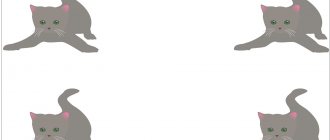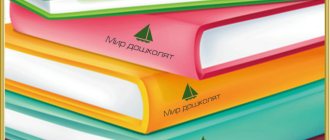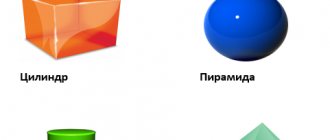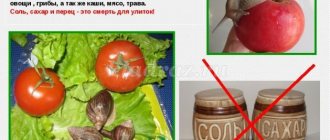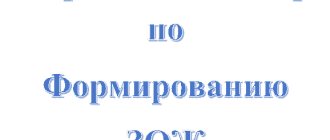Goal: Testing mathematical knowledge in a playful, entertaining form: in counting, the ability to independently complete tasks in a competitive environment.
Objectives: Educational: Learn to solve problems involving increasing and decreasing a number by several units. Strengthen counting within 8, knowledge of numbers up to 8. Developmental: Form in children ideas about the relationships of numbers in a number series, identify and name the previous and subsequent ones in relation to the named number (numbers and “neighbors”). Develop attention, memory, thinking. Educators: Develop the ability to work in a team, provide assistance, support, endurance and patience.
Materials, tools, equipment: Demonstration material: a set of numbers from 1 to 8, cubes, 3 hoops, multi-colored apples made of colored paper. Handouts: geometric shapes, cards with numbers.
Vocabulary work: Digital city, numbers “neighbors”, travel, right, left, below, up, around, previous, next.
Preliminary work: introducing children to the number and number 8, time of day, problem solving.
Methods and techniques: game motivation, questions for children, explanation, instructions for implementation, practical actions of children, musical accompaniment, didactic games.
OOD progress:
1. Organizational moment Communicative exercise “Hello.” Educator. Today we are going to the amazing country of Mathematics. In the capital of the country of Mathematics - Digital City - we will play, count and solve fun problems. And to get to the country of Mathematics, you need to close your eyes and say the magic words: “1, 2, 3, 4, 5 We begin to play! We close our eyes, We find ourselves in the country of Mathematics! (the teacher puts on a cape, a crown, turns into a fairy Mathematics) Fairy. I am glad to welcome you to my city Tsifrograd! But you can't just come here. You need to solve fun problems and show the answers in numbers.
2. Warm up. Solving problems involving increasing and decreasing a number by several units. 1) How many boots did Olya buy so that the cat wouldn’t get her paws wet? (4) 2) Seryozhka fell into the snow, and behind him - Alyoshka, And behind him - Irinka, and behind her - Marinka, And then Ignat fell, How many guys are there in the snow? (5) 3) On Andryusha’s saucer are four yellow pears. The child wanted to eat, and he ate one of the pears. Now count the pears on Andryusha's saucer. (3) 4) A hedgehog walked through the forest, Found mushrooms for lunch: Two under a birch tree, One at an aspen tree, How many of them will there be in a wicker basket? (3) 5) Five puppies Plus mother - husky. How much will? Count it up! (6) 6) Six cheerful bear cubs are rushing into the forest to pick raspberries, But one baby is tired, Has fallen behind his comrades, And now find the answer: How many bears are ahead? (5) (cards with numbers are arranged on a magnetic board in a different order) Fairy: Guys, you solved the problems correctly! Therefore, I invite you to the land of Mathematics. Do you know that bears in my country love mathematics, they know how to solve problems, add and subtract, and also have fun and play. I invite you to play too.
Physical education minute. Song of a teddy bear (ry - ra - ru).
3. Didactic game “Fold the house.” Fairy: One bear cub, in my country, does not have his own house. He knows a lot of geometric shapes and wants to build a house out of them, but doesn’t know how. Shall we help him? Geometric shapes are waiting for you on the table. Fairy: You have created wonderful houses! What geometric shapes did you use? There are so many houses, but only one bear. He will choose a house for himself, but what to do with the rest of the houses? Can I give these houses to the residents of my fairy-tale country?
4. "Game with apples." Fairy: The bear already has a house, but let's treat the bear with apples. Apples are not simple, with different numbers of seeds inside. You will run to the music, and as soon as it stops, take one apple at a time. Count the seeds in the apples and stand near the number in the hoop. How hard you tried! All the apples have been collected. Tired. It's time to relax!
5. Physical education (with musical accompaniment)
6. Didactic game “Live numbers”. Fairy: Have you rested? And in my country, Mathematicians, there are living numbers. Do you want to play with them? Cards with numbers are laid out on the table. Children take them and insert them in order from 1-8. The teacher suggests making a count: quantitative, reverse. Tasks: - Show the “neighbors” of the number 5 and name them. - Show the “neighbors” of the number 7 and name them. - Show the number 1 more than 2. - Show the number 1 less than 4. - Show the number before the number 8. - Show the number after the number 5. - Show the number to the right of the number 4. - Show the number to the left of the number 7.
7. Didactic game “Find the number.” (children stand in 2 teams) Rules of the game: Come to me! There are cubes in front of you. Yellow cubes and green cubes. I'd like you to count them. And to do this you need to split into two teams. Team 1 goes around the yellow cubes and counts them. Team 2 goes around the green cubes and counts them. Each participant takes a card with a number corresponding to the number of cubes passed. Team 1, show cards with numbers. How many cubes? How to check who counted correctly? 2nd team, show cards with numbers. How many cubes? How to check who counted correctly?
8. Reflection. Fairy: Guys, you completed all the tasks! Well done! We will continue to meet with you, but now it’s time for me to leave, and it’s time for you to return. Close your eyes. 1, 2, 3, 4, 5 We're done playing. We close our eyes and leave the fairy tale!
Educator: Our journey has ended. Where have you been? What did you like about the country of Mathematics?
Author: Marina Evgenievna Levicheva, teacher, GBOU school No. 842, preschool department building 137, Zelenograd, Russia
The article is published in the author's edition
Mathematical holiday for children of senior preschool age
- July 20, 2010
Competition “My Pedagogical Initiative”
Program content:
- Bring children joy and pleasure from educational games.
- Maintain interest in intellectual activity, the desire to play games with mathematical content, showing persistence, dedication, and mutual assistance.
- Develop basic skills of algorithmic culture of thinking, the ability to perform actions in the mind; identify and abstract two properties.
- Consolidate the acquired knowledge:
- 1) knowledge of numbers from 1 to 10;
- 2) the ability to compare strips by length;
- 3) the ability to compose cut pictures into 5-6 parts;
- 4) the ability to solve mathematical riddles.
Characters:
- Presenter
- Baba Yaga
- Koschei the Deathless
- Queen of Mathematics
The progress of the holiday
The hall is decorated with mathematical symbols. In the background there is a fairy-tale house in which sits the Queen of Mathematics and Koschey the Immortal. The house is entangled with chains and locks.
Children, divided into two teams, enter the hall and sit on chairs around two tables. Beautiful festive music sounds.
Presenter: Guys, today, in this wonderful hall, we have a Mathematical Holiday, but let's wait a little, since the Queen of Mathematics herself promised to come to us. As soon as she arrives, we will begin our holiday.
The door opens and Baba Yaga runs in.
Baba Yaga: Oh, I'm running, I'm running, I'm all here, I'm here, everything is fine, we can start!!!
Presenter: Guys, do you think this is the Queen of Mathematics?
Baba Yaga: What are you talking about? I am the real Queen of Mathematics, and if you don’t believe me, then I will leave, let the holiday be without me - sit here and be bored!
Presenter: Come on, don’t be upset, you don’t need to leave. We will now check if she is telling the truth. Guys, let's tell her some math riddles.
Children ask riddles:
Three little bunnies, five hedgehogs. They go to kindergarten together. We'll ask you to count how many kids there are in the garden.
Baba Yaga: Well, well, let me think, that means three hares and five hedgehogs, well, that’s easy, only 10, because hares are very voracious, we can assume that there were 5 of them.
Five pies were in a bowl. Lariska took two pies, her pussy stole another one, and how many were left in the bowl?
Baba Yaga: Oh, this Lariska, oh, this pussy - apparently they love pies, they probably all ate them and didn’t leave a single one for the beautiful granny. Zero, zero pies left - we ate them all!!!
Our cat has five kittens, sitting side by side in a basket. And the neighbor's cat has three! So cute, look! Help me count, what is three and five?
Baba Yaga: How can I know how many of these kittens there are, three, five - in general, a lot of these kittens!!!
Presenter: Yes, you are not the Queen of Mathematics. Do you know what our Queen thinks? She knows everything about numbers, numbers, geometric shapes... Guys, I think this is Baba Yaga!
Baba Yaga: No, I am the Queen, the Queen of Mathematics!!!
Voice from behind the house: Don't believe her, guys! This is Baba Yaga, she hid me behind locks, and Koschey the Immortal watches over me day and night.
Baba Yaga: Well, everything has been revealed, I didn’t manage to be the Queen of Mathematics. Come out Kosha, sit here, look at the guys, remember them - they’re pretty, smart, reasonable, they know everything, I couldn’t deceive them, we won’t take them to our team!
Koschey the Immortal comes out, wearing a chain with keys to the locks on his chest. Each key is shaped to fit the lock - children need to match the key to the appropriate key.
Presenter: Baba Yaga, Koschey the Immortal, why are you so angry! The guys came to the party, and you are hiding the Queen! Free her please!
Baba Yaga: Okay, I will fulfill your request if you answer my questions and complete all the tasks correctly. Can you handle it, guys? Then the first task. Game "Live Numbers"
Children are given cards with numbers from 1 to 10; children must line up to the music. The task becomes more complicated, you need to stand in reverse order - from 10 to 1.
Baba Yaga: Well done guys, you completed the task! Give them the key, Kosha. (Koschei gives one of the children a key). If you pick up the key to the lock, only then will it open.
The child picks up the key to the lock. Koschey removes the chain.
Baba Yaga: One day my broom failed me and I had to land in a swamp. And in the swamp, the hummocks are in the form of geometric shapes. You need to arrange the hummocks in the swamp as shown in the diagram on the screen. Place the pieces correctly and you will receive another key.
The plan is displayed on the screen:
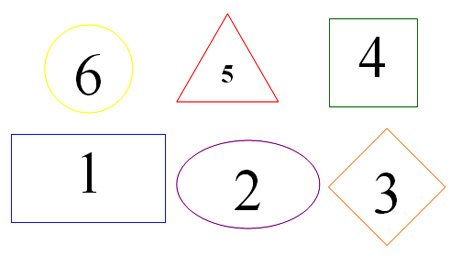
The presenter draws the children's attention to the fact that in the lower left corner there is 1 bump - rectangular, blue, and then an oval bump, purple, etc. Children lay out the figure according to the plan (the figures are made of foam rubber and covered with colored fabric). Then Baba Yaga asks one of the children to guide her over the bumps, in order.
After completing the task, Baba Yaga orders Koshchei to give him another key, the children remove the second chain with the lock.
Baba Yaga: And now I will give you another task. I decided to buy rugs for my hut, but the rugs are not simple, but modern, with a pattern of geometric shapes. You need to decorate the white rug like in these pictures. If you succeed, you will receive another key. And while you are decorating the rugs, I will have fun with the guests and see how they cope with mathematical riddles!!!
Baba Yaga asks riddles to the guests of the holiday:
Along the ravine walked a cap, two scarves, three baskets, and behind them walked stubbornly a snow-white Panama hat. How many guests were there in total? Answer quickly! (4)
One evening the bear’s neighbors came to have a pie: a hedgehog, a badger, a raccoon, a “squint”, a wolf with a tricky fox. But the bear could not divide the pie among everyone. The bear was sweating from labor - he didn’t know how to count! Help him quickly - count all the animals. (7)
Seven cheerful piglets stand in a row at the trough. Two went to bed, how many pigs are there in the trough? (5)
Four goslings and two ducklings swim in the lake and scream loudly. Well, quickly count - how many babies are there in the water? (6)
At the market, a kind hedgehog bought boots for the family. Boots that fit your feet, a little smaller ones for your wife. With buckles - for the son, with clasps - for the daughter. And he put everything in a bag. How many legs does a hedgehog have in a family? (16)
After the riddles, Baba Yaga checks the completion of the task by the children.
Baba Yaga: Give them the third key, Kosha, they completed this task too.
Baba Yaga: And now a competition for team captains. Look, while I was flying over the fields and forests, mice entered my hut and tore up all the pictures from my favorite cartoon. You need to correctly put together my favorite pictures, if you do it, you will get the key.
Baba Yaga: In the meantime, the captains are putting together pictures, for you guys, my difficult logical relay race. You need to enter the desired picture one by one, do it, and get the key.
Queen of Mathematics (voice from the hut): Hurry up, guys, and try not to make mistakes!!!
Baba Yaga: I screamed here, as soon as they cope, we’ll let you out, but if they don’t cope, excuse me, you’ll live with us and teach us mathematics!!!
"Logic relay race".
The teams on the Whatman paper are given logical chains that they must complete.
After completion, the fourth key is given.
The captains are checked and the fifth key is given.
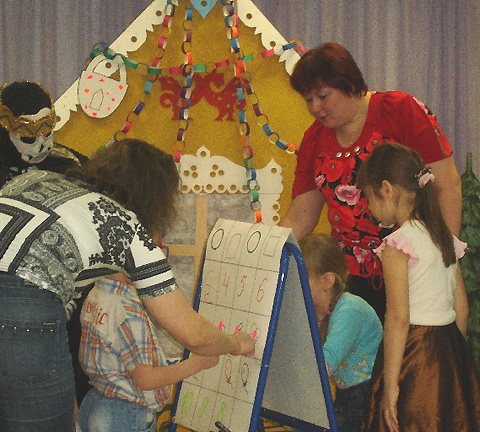
Baba Yaga: Well, well done. They cope with all tasks... So, to make it even more difficult for you to come up with...? A! Now I’ll play the game “Say the other way around” with you. I say a word, and you tell me the opposite word, an antonym. Will you try it? Then listen:
High - low Loud - quiet Wet - dry Clean - dirty Wide - narrow Deep - shallow Strong - weak Big - small Narrow - wide Left - right Front - back Bottom - top Hot - cold
Baba Yaga: Well, well done guys, you completed this task too! Give them, Kosha, the sixth key! Koscheyushka, there’s only one lock left! These are some smart kids. Okay, let me give them one last task. Let them be without their Queen a little longer.
Baba Yaga: Look, I have children’s faces in the envelope, and a small village is drawn on the easel. You need to settle the children as I tell you, and Koshchei and I will check.
Each child is given a face (on an adhesive base or tape), in turn, each is given the task:
1. Olya lives in the lowest building on the 4th floor in the apartment on the left.
2. Denis lives in a house that is located between the highest and lowest building on the 5th floor in the apartment on the right.
3. Sonya lives in the tallest building on the 8th floor in the apartment on the left.
4. Serezha lives on the floor above Sonya, in the apartment on the right.
5. Katya lives in the middle house in the apartment on the left.
6. Maxim lives in the tallest building on the 6th floor in the apartment on the right.
7. Arseny lives in the lowest building on the 2nd floor in the apartment on the left.
Presenter: Well, Baba Yaga, our children have completed their tasks, give us the last key.
Baba Yaga gives the key, the door opens. The Queen of Mathematics enters to the accompaniment of solemn music.
Queen of Math: Thank you guys! It’s not for nothing that you spend so much time studying mathematics. You completed all the tasks and helped me free myself. As a reward for your intelligence and ingenuity, I want to give you gifts, and you, Baba Yaga and Koschey the Immortal, will now go to school to gain intelligence and after all the lessons, you will not have time for pranks, but will be with kids compete to see who is smarter and more savvy.
Presenter: Thank you, Queen of Mathematics, thank you, Baba Yaga and Koschey, for coming up with interesting tasks for us, and now let's say goodbye to our guests! Goodbye!!!
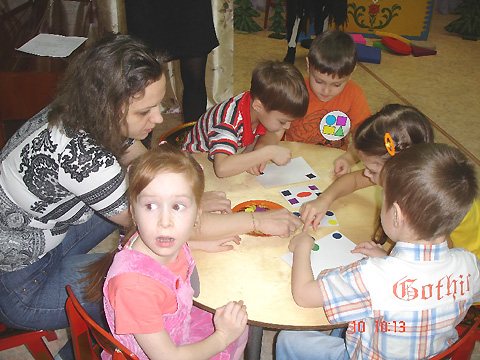
Author: Liliana Anatolyevna Ponomareva, senior teacher of the 1st qualification category of MDOU No. 2 in the village of Afrikanda, Murmansk region, work experience in the position - 4 years
About myself: I have been working at MDOU No. 2 as a senior teacher since 2006. I really love my job and my team. Working as a senior teacher, you realize all the responsibility for the quality work of teachers, for their development, for their comfort in the workplace. I believe it is necessary to create such conditions so that educators feel the need for innovation and enjoy creativity in the workplace. If the teacher is interested in creating, it means that the children will be interested, and parents will be calm about the development of their children. That is why I always take part in the development of all kinds of scenarios and lesson notes. I offer a script for a math holiday for older preschoolers, which we held at a city workshop.
Liliana Anatolyevna Ponomareva
Photo by the author
In their activities, modern teachers carry out the mathematical development of preschoolers through “mathematical entertainment”.
In modern methodological literature, this concept is used in two main senses:
- - as a type of entertaining material, including various puzzles, mazes, mathematical jokes, games on spatial transformation, etc., widely represented in collections of entertaining mathematics, interesting in content, entertaining in form, distinguished by unusual solutions, paradoxical results
- - as a special, special form of organizing joint activities of children, exciting and attractive, organized by adults to expand, enrich or consolidate mathematical knowledge, skills and abilities and their practical application in non-standard conditions and situations.
Traditionally, entertainment organized in kindergarten is divided into types based on:
content (literary, musical, sports);
forms of conduct (attractions, competitions, leisure);
children's activities (games, fun, concerts, dramatizations);
materials and equipment (theaters of toys, dolls, pictures; radio, television programs; cinema, television films);
according to the degree of independence of children:
spectacular entertainment, concerts, performances organized and performed entirely by adults; concert-type entertainment and performances organized by adults with the participation of children;
entertainment prepared on the initiative and with the active participation of children with the help of adults and other signs.
In her works, the author Nepomnyashchaya R.L. (23;143), by analogy with children's games, highlights:
story-based entertainment;
plotless mathematical entertainment.
The author considers plot-based entertainment with elements of dramatization and role-playing games.
Plotless entertainment includes those that are structured as fun competitions, contests, and quizzes similar to sports activities.
In the pedagogical process, entertainment of a mixed nature is most often used, combining individual elements in different proportions, in which the actions of children and adults are combined. Adults usually direct the actions of children, supervise them, hold competitions, games, and introduce exciting surprises. Such entertainment, where adults participate along with children, is usually the most interesting.
Preschoolers have access to the simplest types of entertaining tasks.
In terms of developmental impact on children, I use the following main types of mathematical entertainment:
- 1. Interesting questions, joke tasks.
- 2. Puzzle problems
- 3. A group of games for composing (modeling) flat or three-dimensional images of objects (“Pythagorean Puzzle”, “Tangram”, “Pentomino”, “Cubes for Everyone”, “Corners”, etc.).
- 4. Ingenuity tasks
With the help of well-organized entertainment, it is possible to reveal the level of knowledge of both the entire group - children, and each child individually. Analysis of children’s answers and actions indicates “how well the children have mastered the program material in mathematics, whether they can apply this knowledge when solving problems formulated in a new way, whether they easily understand the meaning of practical tasks, whether they act logically and prove the correctness of their answer.” Entertainment will bring joy to children if its preparation and implementation is organized without haste and overload, and the teacher takes into account the interests and capabilities of the children.
The use of entertaining mathematical material helps to make the entertainment original and varied: mathematical games, riddles, puzzles, geometric constructors, logical games and exercises, labyrinths, puzzles, etc.
Thus, when developing the content of mathematical entertainment for preschool children, we rely on their experience, interests, capabilities and take into account not only the level of mathematical training, but also the features of the development of gaming, cognitive, motor and those types of productive activities (visual, constructive, etc.). ), which are turned on when performing various tasks.
